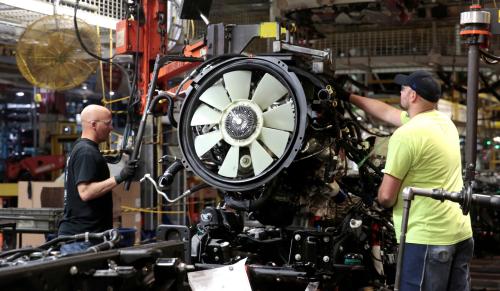When a durable recovery strategy from the COVID-19 pandemic finally emerges, it will confront not just one badly damaged economy, but numerous fractured economies. The pandemic recession is hitting some sectors harder than others, with regions dependent on manufacturing and hospitality particularly devastated. Even state and local government jobs have taken a hit, which will likely get worse in the coming months. And within these hard-hit industries, the young, the less educated, and workers of color have borne the worst of the job losses.
For many of these workers, their old jobs won’t be coming back, even as the economy continues to reopen. Industries likely to expand in response to the pandemic—health care, medical device and supply manufacturing, and telecommunications equipment and software to support remote work and learning—require particular skill sets and greater education and training than many laid-off, lower-skilled workers currently possess. Additionally, evidence suggests that recessions cause many employers to permanently raise skill requirements as they retool their operations, making remaining jobs further out of reach for job seekers.
Despite this dire picture, local leaders can take steps to ameliorate the damage and accelerate recovery in their communities, even as budgets are stressed and federal aid is uncertain. We have identified several community-driven, evidence-based approaches to better link and prepare workers for the good jobs that do and will exist. Implementing these initiatives often requires community leadership, partnership-building, and better leveraging of existing resources. Such coordination can be harder to achieve than, for example, grants to conventional training programs. But it is also more likely to generate true economic opportunity and help overcome long-standing inequities in education and employment practices affecting people of color.
Place-based scholarship or “Promise” programs can be an effective tool to increase residents’ skills, not just by helping more residents get needed postsecondary education, but also by attracting highly skilled newcomers and families that value education. Promise programs can also close educational attainment gaps and deliver on community equity goals, increasing skills and improving workforce outcomes broadly across racial and demographic groups. Some programs now include apprenticeship opportunities in manufacturing, nursing, and IT. In some cases, funding for these programs comes from private sources, but many draw revenues from relatively stable tax increment financing, state funds, or federal transfers.
Promise programs to increase workforce skills can also be relatively inexpensively extended to adult learners, as the Tennessee Reconnect and Kansas City Scholars programs demonstrate. They can also be crafted to support pathways to good jobs for specific groups of workers; Michigan’s recently announced Future for Frontliners program will use CARES Act funding to provide targeted scholarships for essential workers. And several programs, such as Detroit Promise, provide coaching and other forms of academic and financial assistance to strengthen students’ progress through local community colleges.
Education-to-workforce pipelines are another option for communities looking to better match evolving employer occupational demands with robust career preparation. These programs involve partnerships between businesses and training providers, with financial support from both as well as other philanthropic sources. One well-known example is P-TECH, a public-private collaboration started in New York City which has now spread to over 100 schools in eight states. P-TECH students take high school and college courses simultaneously, often in STEM fields, while building work experience through mentored, paid internships in IT, health care, and manufacturing. Many of these students have jobs waiting for them at the end of the program. Early and middle college programs like P-TECH that integrate secondary and postsecondary education are particularly powerful in enhancing learning outcomes for at-risk, low-income, and minority students.
In other cases, nonprofit intermediaries—supported by philanthropy and placement fees—provide sectoral training and soft skills that evolve in near real time with employers’ needs. Per Scholas, for example, provides IT job training and placement services free of charge to economically disadvantaged adults in several cities, with proven results on employment and earnings. San Antonio’s Project QUEST has long provided a well-documented, successful approach for employer-driven training initiatives in specific occupational clusters. More broadly, registered apprenticeships can connect individuals with training for high-demand jobs, but these work best when many local employers and school systems are on board.
Adopting customized business services and new technologies for job searching are also strategies that communities could use to match employer skill demand with local worker supply. Traditional economic development relies too heavily on tax incentives to businesses, while traditional workforce development relies too much on general training. Neither works particularly well. In contrast, training that is customized for specific employers or narrowly defined industries has been found to be a cost-effective employment strategy that tends to benefit local workers. Funding for such training can be repurposed from budgeted tax incentives and state and federal training grants.
New tools and technologies can also be deployed to help job seekers better access information about available jobs and the skills and training needed for them. Researchers from the University of Illinois and George Washington University recently partnered with Michigan Works! Southwest, a local workforce development agency, to design an app that supports personalized job-matching based on a job seeker’s skills and local job postings. Such apps could be open source and draw on existing local data, and thus become widely scalable for other communities. This could help level the playing field when workers don’t have extensive social and job referral networks. On the hiring side, programs such as HireReach help employers use data-driven techniques that holistically map candidate skills against job demands, reducing unconscious racial bias in hiring and the turnover rate of new hires.
We don’t know exactly what the post-pandemic economy will look like, or the extent to which it will reshape communities throughout the country. But it is almost certain that the needs for workforce adaptation will be greater than what small-scale, local programs can deliver, no matter how well-designed they are. National efforts—think of a G.I. Bill for adults to learn new skills through shorter-term, high-return programs—deserve serious consideration, especially if combined with customized career guidance based on employer needs.
Congress is currently mired in gridlock over plans for further relief aid, and federal reinvestment in human capital is uncertain. Communities should not wait for help, but instead take the initiative in rebuilding their economies.








Commentary
In many communities, COVID-19 will permanently kill jobs. Here’s how they can respond.
September 17, 2020